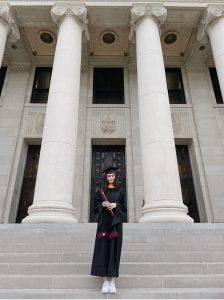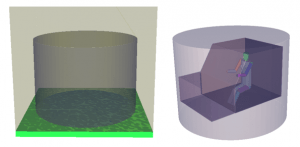
Congratulations to Sena Dalak, RED²’s latest graduate! Sena graduated this past summer with an MS in Nuclear Engineering under Dr. Dewji. We had a chance to sit down with Sena to share her graduate experience in the RED² Laboratory.
Thesis title: “Estimation of Protection Factors for The Transport of Radioactive Material” (details here).
- Please describe your project(s) work you conducted in the RED² Laboratory.
- I performed radioactive material transportation studies using Type A and Type B packages simulated in MCNP and U.S. Nuclear Regulatory Commission (NRC) code, RADTRAN, to conduct transportation regulatory risk assessment. In this study, I have experienced challenges to find experimental data to compare the results of my MCNP simulations and to find some answers related to the code RADTRAN. Because of these challenges, this work could not go further.
- I analyzed vehicle radiation protection factors (RPF) to determine shielding protection from external radiation sources with realistic representative models; included phantoms in realistic driving postures generated with the US-NRC Phantom with Moving Arms and Legs software. The limitation of this study was to find proper dimensions of a vehicle (military/civilian) and a trailer to simulate in MCNP however, I solved this problem producing a vehicle and a trailer from a computer-aided design (CAD) model implemented in MCNP by making use of Rhinoceros with the Grasshopper add-on. Then, the dose limits are evaluated using 2011 Fukushima environmental data for consequence management using NCRP recommendations.

- What scientific/technical tools/methods did you use/learn to conduct your investigation?
I have developed proficiency with of several analytical tools, such as MCNP, RADTRAN, PIMAL, Vised, Python, Radiological ToolBox, and the recommendations and guidelines provided by governing/regulatory bodies (e.g., IAEA, NRC, and ICRP).
- What non-technical skills did you develop as a result of your experiences? Did you present at any conferences or win any awards because of your research?
I believe that I have developed my strengths include being a good team player and having a good communication from my experience working with my research group. I presented my work at the STC-HPS 2021 Virtual Spring Meeting and the 66thAnnual Meeting of the Health Physics Society. I also received an Education Grant from STC-HPS and Travel Grant from HPS.
- What was the impact of your work ? Where are you headed next?
My work has been submitted and will be published by the Health Physics Journal, where I have also presented at the STC-HPS 2021 Virtual Spring Meeting and the 66th Annual Meeting of the Health Physics Society. My career goals would be to first begin as a radiation specialist and gain some experience and eventually lead a team of radiation specialists. As of September, I will be working on transportation of radioactive materials at the Turkish Nuclear Regulatory Authority as Assistant Specialist.
- What excited you the most about your experience with RED²?
Gaining experience in an academic environment under my advisor [Dr. Dewji] and being able to accomplish publishing some of my work and presenting at a professional conference.





